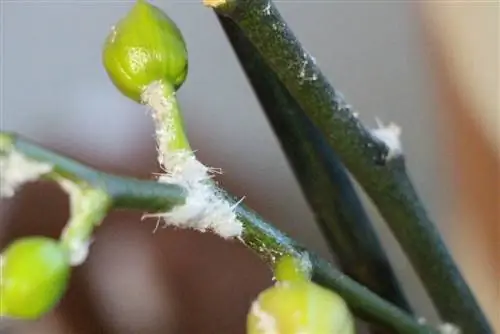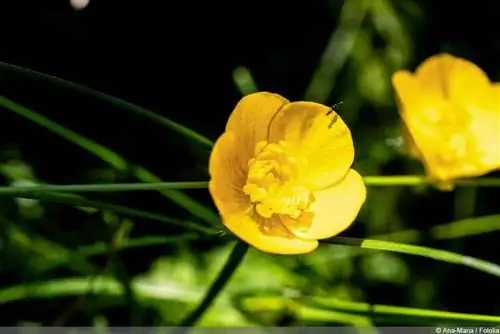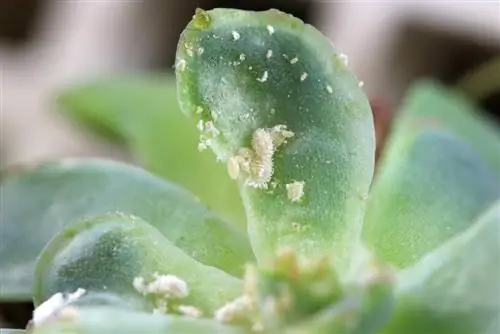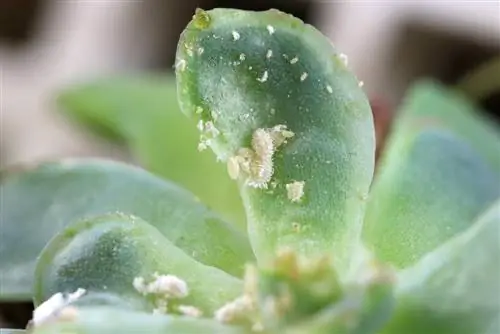- Author admin [email protected].
- Public 2023-12-17 03:39.
- Last modified 2025-01-24 12:45.
If cacti become ill, it can have many causes. In the vast majority of cases, care errors are to blame. However, it sometimes happens that the succulent plant is also attacked by pests. You should therefore regularly examine your plants in detail. Before you do anything, the first step is to identify the pest. Only then can effective control take place. Recognizing mealybugs on cacti is relatively easy. Fighting them effectively, however, is a challenge.
Identification
Mealybugs, also called mealybugs (Pseudococcidae), belong to the scale insect family and include around 1000 different species, which differ primarily in the hairiness and the length of the black threads. Their size varies between one and twelve millimeters. In Europe we are mostly dealing with two types of mealybugs:
- Citrus mealybug (Pseudococcus citri)
- Long-tailed mealybug (Pseudococcus longispinus)
The female animals live stationary on the plant after sucking and can be found on practically all parts of the succulent. However, they prefer to nest in indentations and in armpits. The body of the lice is covered with white hair. The parasites protect themselves with whitish wax secretions that allow moisture to simply roll off. Mealybugs multiply very quickly and can migrate throughout the entire cactus collection.
Root lice
Some species of mealybugs prefer to live below ground level and only suck on the roots of the plant. That's why they are also called root lice. They are extremely difficult to recognize and are usually only noticed when the cacti are repotted or when the disease is clearly visible. If you pull the root ball out of the pot, the white smear marks typical of this type of lice are visible on the inner walls of the pot.
Symptoms
An infestation with mealybugs affects both the vitality and various growth processes of the plant. However, the parasites not only suck out the sap of the cacti, which leads to symptoms of weakening. At the same time, the lice secrete toxic substances through their saliva, so that parts of the succulent initially turn yellow and then die. In contrast to the darker, encapsulated scale insects, mealybugs can be easily recognized on the affected plant due to their white web.
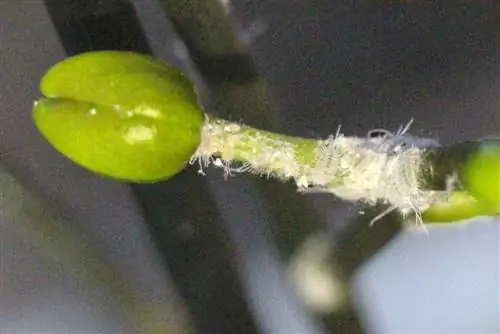
Like many other species of lice, mealybugs also excrete honeydew as a waste product. This appears as a small, sticky drop on the plant. Honeydew contains sugar and is a popular food source for various insects such as ants. If the honeydew is not harvested by insects, colonization with sooty mold fungi usually occurs quickly. Although this fungus does not directly damage the cactus, it can hinder photosynthesis.
Combat
If a cactus is infested with mealybugs, it must be isolated. This is the only way you can prevent the pests from spreading further to other plants. Move the infected cactus to another room where there are no other plants.
Direct Action
1. Mechanical cleaning
If the trunk succulent is already heavily covered with white webs, mechanical cleaning must first be carried out before the actual control.
- Collect lice with tweezers
- remove remaining webs and eggs with a soft toothbrush
- best under running water
- protect the roots from moisture with a plastic bag
2. Repotting
Mealybug eggs lying on the substrate are difficult to detect and even more difficult to remove. Since there is a risk of new infection if eggs are lying in the ground, the substrate should be removed as much as possible.
- pulling the cleaned cactus out of the plant pot
- scrape off top substrate layer
- remove as much substrate as possible
- Wash the pot with hot water and soap
- insert into fresh substrate
Tip:
The earlier a mealybug infestation is detected, the easier and more effective it is to combat the pest.
Further treatment
Purely mechanical removal of mealybugs is usually not enough to completely remove the pest from the cactus. Often eggs and larvae adhere very tightly to the grooves or are found in hard-to-reach places under thorn clusters on the ribs or warts of the plant. Because the eggs and larvae are very small and often invisible to the naked eye, you will need a magnifying glass to inspect them. No matter what type of mealybug it is, the fight is always the same.
Soap solution
On the following days, the plant should be sprayed or brushed several times with a soap solution. Make sure that large amounts of solution do not get into the potting soil and thus onto the roots. A suitable solution consists of:
- 15 ml soft soap (do not use hand soaps, shower gels etc.!)
- 12 ml spirit
- 1 l water
Repeat the treatment after one week and after 14 days to kill any offspring of lice that may have developed from the larvae and eggs in the meantime.

Neem oil
Neem oil (neem oil) can be purchased pure or as a ready-made organic pesticide. Mealybugs living above ground can be dabbed with the oil using either a cotton ball or a fine brush. To a certain extent it also helps when used as a watering agent against lice in the soil. However, these pests are better protected and usually cannot be completely eradicated with contact poisons. Pure neem oil is not suitable for treatment with irrigation water because the oil does not mix with water. In this case, a systemic preparation (e.g. neem oil emulsifier) is necessary.
- Use only very diluted for watering
- Concentration about 0.05% neem oil emulsifier (0.5 ml to 1 l)
- Use the product according to the package leaflet
- Water plants only to the normal extent
Spirit
Instead of neem oil, pure spirit can also be used to dab the pests. Spraying the cactus is only recommended when it is dormant in the winter. Alcohol is able to penetrate the shell of the lice and quickly kill the parasites.
Paraffin oil
Mixtures of paraffin oil in water are also safe for humans and pets. In order for the paraffin oil to penetrate the lice's water-repellent protective shield, a small amount of surfactant in the form of neutral soft soap is necessary. A solution suitable for spraying or brushing consists of:
- 1 liter of water
- 15 g paraffin oil
- 10 g soft soap
Use the solution several days in a row and again after one, two and three weeks to kill hidden mealybugs or their offspring. The paraffin oil clogs the body openings and respiratory organs of the lice, causing them to die relatively quickly. Make sure that the entire soil is not soaked with the solution by covering it with foil or a bag.
Natural enemies
Like most creatures, mealybugs also have natural enemies. They can therefore be combated with suitable beneficial insects. Ladybugs and lacewings are particularly suitable for cacti in winter gardens and indoor areas. Alternatively, parasitic wasps can also be used in the greenhouse. Special cultures are bred for this purpose, which you can order by mail order. If you decide on this natural alternative, be sure to strictly follow the instructions.
Tip:
Even when using beneficial insects, repeated application is necessary after about two weeks.
Ladybug
The Australian ladybird should only be used indoors. On the one hand, it needs relatively high temperatures (above 22 degrees) and high humidity, and on the other hand, it is not native to us and should therefore under no circumstances be released into the wild so that it does not spread here and possibly displace other animal species. Under optimal conditions, Australian ladybirds destroy several hundred pests per day.
lacewings
Mealybugs can also be controlled with lacewing larvae. Their larvae are very voracious and have a wide range of prey. You can use this crepuscular insect in the house and greenhouse all year round. Lacewing larvae are capable of killing about 100 pests per day.

Parasitic wasps
Only certain types of parasitic wasps, such as Leptomastidea abnormis, are suitable for combating mealybugs. In contrast to ladybirds and lacewings, parasitic wasps are mainly used outdoors or in greenhouses. The insects need minimum temperatures of 20 degrees and high humidity to become active.
Systemic pesticides
If the infestation is already very advanced or the home remedies have not shown the desired result, combating it with a pesticide can be the last solution to save the cactus. These preparations use an active ingredient that is harmful to mealybugs, which is usually not applied to the pests, but is absorbed by the plant through the roots. This substance has no consequences for the cactus itself, but the lice absorb it through the plant juices and die.
- available as granules, insecticidal sticks or tablets with dispenser
- The agent reaches all parts of the plant via the plant sap
- Please read the package leaflet
- apply strictly according to instructions
- Repeat treatment after about two weeks
Be careful with spraying products. In addition to the actual active ingredient, these also contain oils that can close the pores in the cactus skin and thus lead to the death of the plant. Always remember that when applying pesticides, contact with skin and eyes should be avoided. Some products also produce fumes/fumes that can stay in the room for days. Therefore, do not place treated cacti in the bedroom or other busy rooms.
Treatment of root lice
Some species of mealybugs prefer to nest underground on the roots of the plant. They are usually only recognized when it is almost too late and the plant can no longer be saved. So that early identification and control can take place, cacti should be checked regularly for these lice on the roots. To check, take the root ball out of the pot at least once a year and take a closer look at the inside of the planter and the root ball. If whitish threads or even small white tufts are visible, it is an infection with mealybugs.
- check warm plants several times during winter rest
- the risk of an infestation is higher in the heating season
- pot out the cactus if infested
- remove entire soil
- Shower the plant and roots thoroughly
- use lukewarm water
- possibly use a soft toothbrush
- Dispose of plant pot in household waste
- Rinse the planter with hot water and soapy water
- Plant cactus in fresh soil and new pot
- quarantine
- Treat with pesticide if necessary
Only put the cactus back in its usual place after checking it again and, as a precaution, check all other plants that were near it.
Prevention
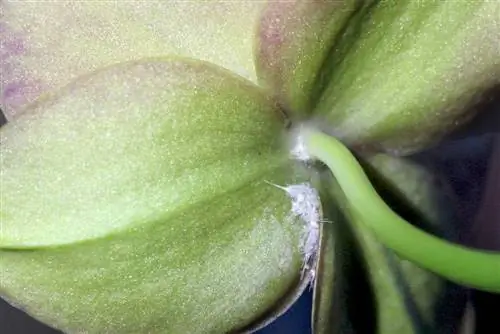
As with other houseplants, prevention is one of the most important measures against any form of pest. The risk of mealybug infestation is significantly higher in weakened cacti than in strong, he althy plants. It is therefore important to ensure the best possible conditions to avoid infection. In addition to a suitable location and proper care, especially in the winter months, regular inspection of each individual plant is one of the key points. Because only with early detection of the pest can it be easily combated.
Newly purchased plants
Even newly purchased cacti can already be infected with mealybugs. If the infestation is not yet advanced, it is almost impossible to detect the lice. There is always the risk of introducing pests into your home collection when you purchase a new cactus.
- repot the plant immediately after purchase
- use new soil and clean pot
- wash previously used containers thoroughly with hot water and soap
- Never plant a plant directly in a planter
- protect from waterlogging
- moist substrate and poor ventilation promotes root lice
If you really want to be sure not to introduce any pests, you should, as a precaution, cultivate all newly purchased plants in isolation from the other cacti for about two weeks.
Conclusion
Once an infestation of mealybugs has occurred, it requires a very high level of attention and care to get rid of the animals permanently. You often get mealybugs when you buy cacti. Otherwise, the pests appear on weakened plants, especially in the winter months. If you act quickly, you can usually contain the infestation with simple home remedies. For very badly infested cacti, often only a pesticide can help.

